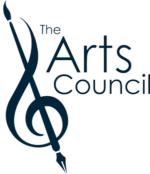
Free Flight
Location: Easterwood Airport, 1 McKenzie Terminal Blvd, College Station, TX 77845
Description: 100 glimmering stainless steel (& expanded metal)- mesh wing shapes, frozen midflutter. The long oval-shaped ‘wings’ are hung from the ceiling in groups to create shapes and forms.
Artist: Taeg Nishimoto
TAMU College of Architecture ‘ArchOne’ newsletter:
‘Free Flight’, Professor’s architectural installation takes off at College Station airport.
Travelers passing through Texas A&M University’s Easterwood Airport are favorably responding, though perhaps subconsciously, to a new abstract sculpture suspended from the ceiling of the airport lobby.
“Prior to the sculpture’s installation last December, we hardly had anyone sitting up there,” explained John Happ, director of aviation at Easterwood. “Nowadays, everyone tends to migrate to that space.”
The attraction, Happ speculates, is the serene atmosphere evoked by the architectural installation, “Free Flight,” an array of 100 glimmering stainless steel-mesh wing shapes frozen mid-flutter and casting an otherworldly aura throughout the public space.
The artwork was designed and installed by Taeg Nishimoto, an associate professor of architecture at Texas A&M University. The project, instigated by Happ, was completed with a grant from the Arts Council of Brazos Valley. Funding for the sculpture’s initial design exploration was supplied by the College of Architecture’s Research and Interdisciplinary Council.
Nishimoto is internationally known for his architectural installations – abstract manipulations of space that are perhaps best characterized as a synthesis of art and architecture. One of his recent works, “Re-f(r)action n(degrees sign) 5,” was featured at the arc en rêve center d’architecture in Bordeaux, France.
The architect tackled the project shortly after joining the Department of Architecture faculty in 2001. He began the design process by spending a great deal of time in the airport – analyzing the space, watching the flow of traffic, and monitoring the variations of light throughout the day.
“Though airports are often depicted in the movies as romantic and exciting places,” Nishimoto said, “the truth is, waiting for a flight can be a real drag, and flying is inherently a bit nerve-racking.”
This observation convinced Nishimoto to pursue a soothing and reassuring solution.
“I wanted the piece to induce an uplifting feeling about the expectation of flight,” Nishimoto said. “I wanted to instill confidence while capturing the very special feeling one gets the first time they fly through the clouds.”
Another of Nishimoto’s initial concerns revolved around the public aspect of the piece and the need for it to appeal to a broad, diverse group. That ruled out esoteric solutions that might otherwise be quite at home in a museum or galley. Such fears were quelled when the final design received unanimous approval from the President’s Advisory Committee on Art Policy (PACAP), the agency that oversees all public art on the Texas A&M campus.
Unanimous approval by the council is a rare event, Happs later told the crowd gathered at the airport for the February 16 dedication of Nishimoto’s work.
The architect envisioned a series of stainless steel expanded metal sheets bent in tension and assembled in two separate areas of the airport lobby – above the ticket counters in the front lobby and from the ceiling of the passenger waiting area that peers out onto the airport runways.
And though Nishimoto had a concrete idea for the abstract installation, he wasn’t sure what it would look like when it was built. The final design would be a spontaneous result of the construction process, with many decisions made on the spot.
“We went through the entire design process during the installation,” Nishimoto recalled. “I had deliberately left things open-ended, allowing room for the final image to evolve. “The procedure,” he said, “is not about placing the object in the space, but more like communicating with the space.”
In mid-October 2003, 100 pre-cut pieces of the expanded metal sheets were delivered to the airport. The sheets had been prepared to Nishimoto’s specifications by Dave Sellers, a 2003 graduate of A&M’s undergraduate environmental design program. Together, Sellers and Nishimoto began bending and arranging the pieces into “wings” and hanging them with wires and cables. During the process, which continued into the busy Christmas travel season, the architect paid special attention to the reactions of holiday travelers.
“While we were working on it, I was nervous because I wanted the design to evoke, in other people, the same kind of images I was dreaming of,” Nishimoto said. “By watching facial expressions and listening to comments as we worked, I began to sense that they were responding to the piece as I had intended. As a result, I gradually became confident in the final design.”
The architect’s confidence was not misplaced. In the four months since the sculpture’s completion, Happ said the installation has been well received by airport patrons.
“There are a variety of interpretations, and I have one of my own,” Happ said of reactions to the airport’s new abstract artwork. “I’ve heard others say it looks like butterflies turning into airplanes. To me, it is like a contrail of a jet aircraft that you see at high altitude – serene and soft, but not in any particular pattern, just swirls. It has been a great enhancement to the airport.”
Nishimoto said the project was truly a group effort in which he served as a catalyst, “putting other’s abstract concepts into a concrete image.”
Fortuitously, the sculpture’s completion and its ultimate use of exactly 100 stainless steel “wings,” coincided with the 100th anniversary of the Wright Brothers’ first powered flight on December 17, 1903.
“I had secretly hoped that we would use 100 ‘wings,’ but I wasn’t sure if that would be too many or too few,” Nishimoto recalled. “Just as we were coming to the last two or three pieces, it seemed like that was going to be just the right amount. That made for a gratifying and appropriate finish.
